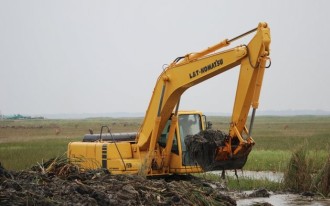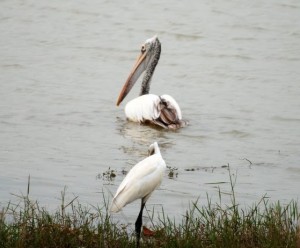Type Naupada into an internet search engine, and you will find a number of results pointing to the socio-ecological sensitivity of this swampy wetland in Srikakulam District of Andhra Pradesh. According to reports of the Important Bird Area (IBA) programme of the Bombay Natural History Society (BNHS), Naupada is critical for the survival of a prime bird habitat. This 15-20 sq. km of brackish swamp is just 5 km from Telineelapuram pelicanry, a globally recognised area for avifauna.
I've never been to Naupada, so I have never had the chance to see its spot-billed pelicans or painted storks. My encounter with the region has instead been through the murky legal texts and a dismal tale of disregard and foul play.
Thermal plant in the offing
The Bhavanapadu Thermal Power Project promoted by East Coast Energy Private Ltd (ECEPL) is proposed to be located right next to Naupada in Kakarapalli village, of Santha Bommali mandal. The project was granted environment clearance under the Environment Impact Assessment (EIA) notification, 2006 on 11 February 2009. The plant is envisaged to be developed in two stages with an ultimate generation capacity of 2640 MW.
But much before the formal approval came, ECEPL was on the job, excavation work had started, and Naupada's water was being drained. A report of the Bombay Natural History Society (BNHS) on the environmental violations by the project authorities stated this clear and strong. More was reported in Volume II of the ERC Journal, February 2009, where it was stated that the project proponents were diverting fresh water away from the swamp to facilitate drainage of the construction site. To achieve this, a diversion canal had also been built.
A steady supply of fresh water is critical to maintain the brackish nature of the a swamp like Naupada. This is what ensures the biological diversity of the area. If the fish and invertebrates die with the habitat, all the visiting birds won't have anything to feed on. By reducing the flow of fresh water into Naupada, the project authorities were impacting the hydrological flow of the wetland, and increasing the salinity of the water.
EAC's objections fly away
The Expert Appraisal Committee (EAC) of the Ministry of Environment and Forests (MoEF) stamped a different fate for Naupada's future. The decision took several months, site visits and considerations. The last two meetings are especially noteworthy for the contradictions they contain. ECEPL's proposal was considered in the 36th meeting of the EAC in December 2008 following a site visit to the area by representative members of the committee. At this meeting the EAC noted that the parts of the proposed project area is used by endangered birds for breeding and nesting. At the meeting, the site was referred to as an "ecological entity of incomparable value requiring conservation and protection".

A steady supply of fresh water is critical to maintain the brackish nature of the a swamp like Naupada. By reducing the flow of fresh water into Naupada, the project authorities were impacting the hydrological flow of the wetland, and increasing the salinity of the water. (Above: Swamp being cleared. Photo by Sohan Hatangadi).
ECEPL returned with a reorganised plan, also reducing its land requirement from 2450 acres to 1995 acres. This plan also entailed reducing 500 acres of marshland from the southern side of the plant. But the project site itself remained the same, shifting neither up nor down from the original location that the EAC had objected to. Nonetheless, the EAC members decided that they were fine with this proposition. At its 40th meeting, the thermal power plant at Bhavanapadu was approved, along with a list of conditions. Ironically, a Conservation Cell was also established - for a project which proposes to choke the Naupada area out of water and bird life.
But what is surely incomprehensible is that in the environment clearnance letter, it is now claimed that Naupada is neither an existing nor proposed migratory path for birds. The area is neither an nesting ground nor foraging ground for "large sized migratory birds".
Observations of the NBWL report
In time, the news about the Bhavanapadu project and its potential impact reached the meeting room of the standing Committee of the National Board for Wild Life (NBWL). This committee was set up in pursuance of the requirements of the Wild Life Protection Act, 1972 and has the critical mandate of ensuring the conservation of wildlife habitat and species accross India, both at the policy level and in specific instances.
One of the members of the Standing Committee is Dr. Asad Rahmani, Executive Director of the BNHS, who brought this up before the committee. It must be noted that BNHS's advocacy officers were one of the first to record the environmental violations of the Bhavanapadu project and its impacts on an Important Bird Area (IBA). The standing committee of the NBWL took note of the matter and decided upon a site inspection of the area. Dr. Asad Rahmani, BNHS and Dr. Asha Rajvanshi from the Wildlife Institute of India (Dehradun) visited the site in December 2009. Interestingly, Dr. Rajvanshi is also a member of the EAC which finally granted environment clearance to the project.
Their report reflected a scathing critique of the Environment Impact Assessment (EIA) report which ECEPL had submitted as part of its environment clearance application. It highlighted that the EIA consultants had deliberately concealed information - they did not mention that there were migratory routes of birds within 10 kilometres of the project site. This is in contradiction to the facts of the EIA report which themselves mention that the project area has several migratory species such as bar-headed goose, shoveller, spotted bill pelican, sarus crane etc.
They further note in their report that the EIA report wrongly states that there are no endangered animal species recorded or reported in the area of study. WII has recorded the nesting of Olive Ridley turtles in this area, which are a Schedule I species under the Wild Life Protection Act.
The inspection report of the NBWL also observed that even though the area is not an officially protected area declared under the Wild Life Protection Act, the Andhra Pradesh Forest Department has acknowledged its importance as a vital nesting site for spot billed pelicans and painted storks, which are two globally threatened species. The area has also been proposed to be designated as a biodiversity heritage site under the Biological Diversity Act 2002.
Recommendations of the NBWL report
The Rahmani-Rajvanshi report does not stop with its critical observations. In its primary recommendation, the report seeks the setting up of a committee to ensure safe-gaurding of the ecological processes and ecosystems of the wetland and Naupada swamp. This committee should also assess the ecological damage done and propose steps for the restoration of the area to its original habitat. Quite significantly, the report points out that the area should have not been allocated for industrial development in the first place. And "ideally", ECEPL "should not have undertaken development on this site and should vacate this ecologically important wetland which should be declared a Conservation Reserve in its entirity."
 Pelicans and storks call this beautiful landscape home. (Photo by Sohan Hatangadi).
Pelicans and storks call this beautiful landscape home. (Photo by Sohan Hatangadi).
The report is dated December 2009, and observes, "no permanent construction has been done so far and only some temporary structures have been erected." So, it would have been an ideal situation, to recognise the area as on which is an entity of ecological importance (which the EAC on environment clearance had done a year back in December 2008), and recommend that ECEPL be asked to move out of the critical bird habitat.
But here is the twist. This report also has secondary recommendations with a full list of mitigation measures to go with the inevitable setting up of a thermal power plant. The logic - since the environmental clearance has already been granted the project authorities will have to show utmost seriousness to not impact the neighbouring wetlands in the area. Therefore, a list of conditionalities and measures follow.
The recommendations read like a bundle of contradictions, each trying to justify the other. In a case when the EIA is recognised as faulty, incomplete and misleading; having argued that the project area should have never been under industrial use; noting that the ecological space is still thriving with birds; pointing out that not much construction has taken place. If clearances cannot be reversed under these circumstances, what hope does one have with action in other instances?
NEAA Case
The environment clearance of the Bhavanapadu plant has been challenged before the National Environment Appellate Authority (NEAA) in Delhi. The petition has been filed by E A S Sarma, a former IAS officer. In a recent hearing on 18 March 2010, the NEAA partially stayed the work on the project by directing that no new filling up of wetland should take place, till the time the appeal is disposed off. It further directed that the proposal for a jetty to be constructed as part of the project is also stayed. Ironically, this was one of the recommendations in the NBWL report as well.
The Ministry of Environment and Forests (MoEF) on its part has constituted yet another committee of 'experts' to study the Rahmani-Rajvanshi report. It is to be seen which direction their views take.























